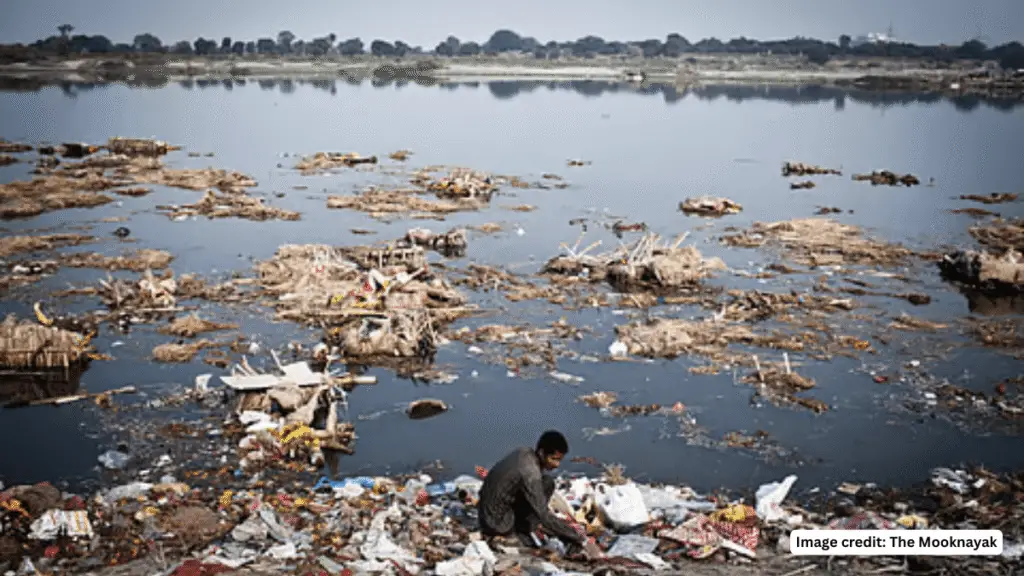The Yamuna River provides over 79% of Delhi’s water supply, serving nearly 57 million people, but today it is referred to as “Delhi’s dying holy river.” Delhi’s 22 km of the Yamuna stretch from Wazirabad to Okhla barrage is the most toxic river among India’s 311 polluted river stretches.
Yamuna is the second largest tributary of the river Ganga. Originating from the Yamunotri glacier in Uttarakhand, the river Yamuna flows across seven states and merges with the river Ganga at Sangam in Prayagraj, Uttar Pradesh.
The Yamuna isn’t just the largest water supply but also has a huge religious significance. Yamuna is worshipped in Hinduism as Goddess Yamuna. Therefore, it is common for people to bathe in the sacred waters to get rid of their sins.
It was not long ago when the Yamuna water was pristine blue and crystal clear. One could literally see his/her face while standing on the banks of this holy river, but now the Yamuna is considered one of the most polluted rivers in the world.
Read more: How Climate Change is Driving Genetic Adaptation- 4 Real Examples.
And who is to blame? It’s us. We are responsible for this.
The prestigious Himalayan river turned into a heavily contaminated waterway, largely due to unchecked human activity. Urbanisation along the banks of the river has resulted in the discharge of untreated domestic waste.
Industries nearby, such as leather tanneries, paper mills, chemical factories, textile dyeing plants, and electroplating workshops, also release effluents containing heavy metals, toxic dyes, and detergents directly into the water.
You might have noticed the river’s surface often shimmers with a white soap-like froth, looking like foam, but it’s not foam; it’s actually a toxic mix of detergents, phosphates, and industrial surfactants.
Much of this comes from untreated sewage; nearly 90% of Delhi’s wastewater flows into the Yamuna without adequate treatment.
Let us now see how this is havoc for our genetics and health.
People who are dependent on the Yamuna, be it directly or indirectly, are the ones who are paying the actual price.
Residents who consume water from the river after inadequate treatment are prone to waterborne illness such as typhoid, hepatitis A and E and gastroenteritis. The ones who live near the river have to face chronic skin rashes, fungal infections, and respiratory issues from inhaling chemical vapors and bacterial contaminants.
And on the other hand, there are fishermen who spend long hours standing in the river and are exposed to even higher concentrations of pollutants.
According to a study published in the journal Springer, the water from the Yamuna river, particularly in its polluted stretches near urban and industrial zones, contains high levels of heavy metals like lead, chromium, mercury, cadmium and organic pollutants.
And the long-term consumption or use of this water can result in various human health issues, including skin diseases, liver and kidney damage and can also weaken the immune function. These heavy metals can accumulate in the body over time, increasing chronic diseases like cancer and cardiovascular problems.
Not only this, but heavy metals and persistent organic contaminants are known to induce oxidative stress, leading to DNA damage. 8-OHdG is a biomarker of oxidative DNA damage and in the populations exposed to this contaminated water, the levels of 8-OHdG were found to be elevated in this study.
Read more: Antibiotics Could Be Weakening Cancer Treatment — Here’s Why.
Prolonged exposure to this contaminated water is associated with an increased risk of gene mutations and disruptions in normal cell cycle regulation, resulting in cancer development and heritable genetic effects.
Other than this, synthetic dyes used in textile production, containing compounds like aromatic amines, are known to be mutagenic. This can cause eutrophication. The altered chemical balance of the water makes it even more toxic to living cells.
Furthermore, the local ecosystem is disturbed by the frothy layer on the Yamuna. Aquatic life is adversely affected by the foam’s toxic components, which reduce the water’s oxygen content. Such polluted conditions frequently make it impossible for fish and other organisms to sustain themselves, resulting in decreased biodiversity.
One more point to be mentioned here is metagenomics. The present metagenomic studies on the river Yamuna showed that human interference and extreme water pollution led to a decrease in microbial diversity and population.
Now, for the sake of our health and to secure the future of our coming generations, it is our responsibility to save our holy river Yamuna. It is a fight for public health and biodiversity.
Not only that, the extremely polluted water is causing substantial alterations to our DNA. When these changes are passed on to the next generation, the altered DNA can weaken our genes and increase the risk of diseases such as cancer.
Initiatives like the Yamuna Action Plan aim to clean the river, though it is appreciable work, but the progress has been slow. Restoring the Yamuna will require the combined efforts of civilians, the government and NGOs.
It’s our fight to save not just a river but a heritage, a lifeline and our DNA.
Resources:
- “Financial Express.” Financialexpress.com, Financial Express, 8 Nov. 2024, www.financialexpress.com/life/yamuna-river-pollution-how-toxic-frothy-water-can-have-harmful-effects-on-your-body-3659794/.
- KNOWLEDGE, ATTITUDE and PRACTICE of DELHIITES towards the RIVER YAMUNA by a Report. 2009.
- Sharma, Madhuben, et al. “The State of the Yamuna River: A Detailed Review of Water Quality Assessment across the Entire Course in India.” Applied Water Science, vol. 14, no. 8, 16 July 2024, https://doi.org/10.1007/s13201-024-02227-x.
- Mittal, P, et al. “The metagenome of a polluted river reveals a reservoir of metabolic and antibiotic resistance genes.” Environmental Microbiome 14, 5 (2019). https://doi.org/10.1186/s40793-019-0345-3.


